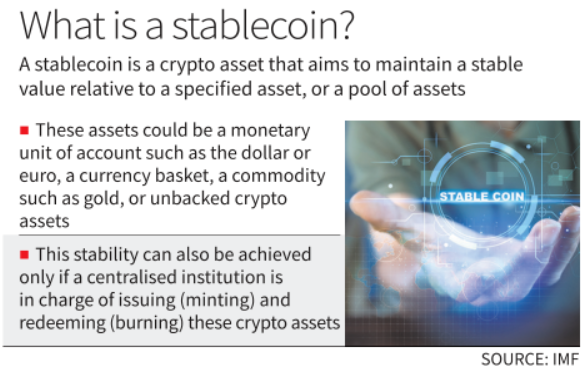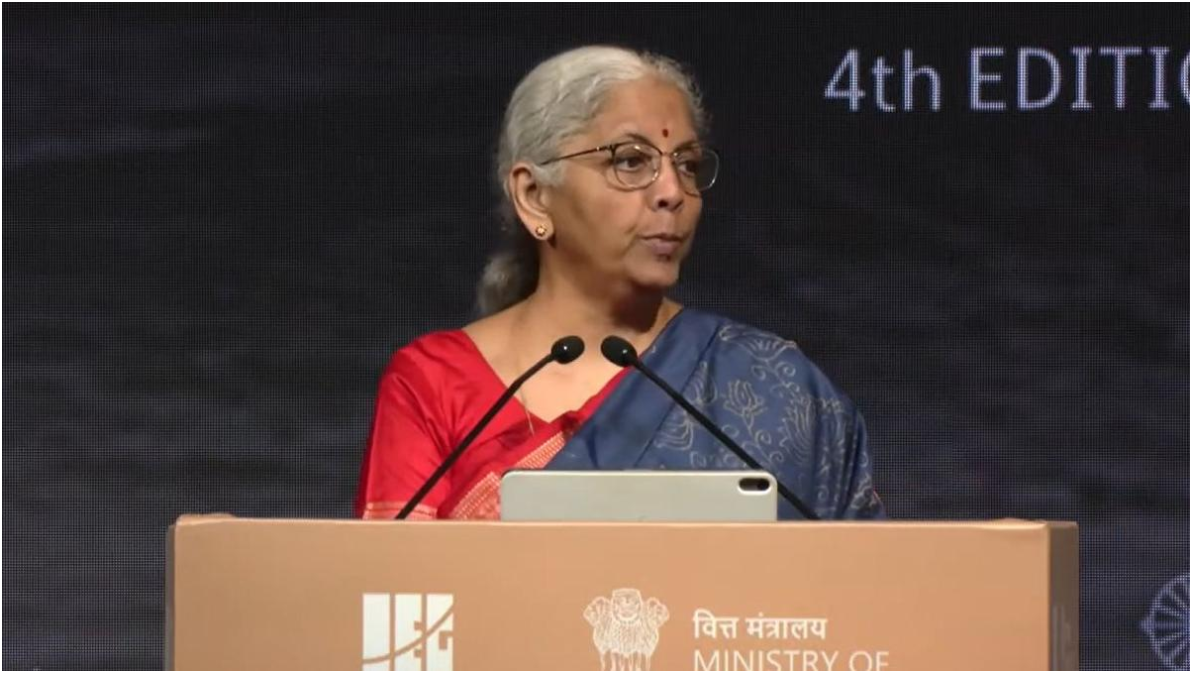Description
Copyright infringement not intended
Picture Courtesy: The Hindu
Context:
Finance Minister Nirmala Sitharaman) said that countries would have to “prepare to engage” with stablecoins.
What are Stable Coins?
Stablecoins are a form of cryptocurrency that attempt to maintain stable prices as they are pegged to an underlying asset, such as a basket of currencies or precious metals.

Importance of Stable Coins
- This makes them suitable for everyday transactions and contracts, unlike volatile cryptocurrencies.
- They provide a stable unit of account and store of value in decentralized platforms.
- Cross-border payments using stablecoins are faster and cheaper than traditional systems like SWIFT.
- Useful for remittances, especially in regions with limited access to banking.
Stablecoins vs. Cryptocurrency
- Value Stability: Stablecoins aim to keep their price constant whereas Cryptocurrencies like Bitcoin fluctuate in price due to market forces.
- Risk: Stablecoins carry less price risk, Cryptos are riskier due to price swings but offer higher potential returns.
- Functionality: Stablecoins are mainly used for everyday transactions, and as a trading pair. Cryptocurrencies are used for investment, mining rewards etc.
- Backing: Stable coins are backed by assets like gold, RBI reserves etc. but Crypto’s are not backed by anything.
Benefits of Stable Coins
- Minimizes volatility compared to regular cryptocurrencies like Bitcoin or Ethereum.
- Enables instant global payments.
- Acts as a stable unit of account in decentralized platforms.
- Ideal for merchants or users who want stability without relying on banks.
- In countries with unstable currencies, stablecoins offer a asset-pegged alternative.
Why Stablecoins not suitable for India?
Indian Payment Systems Are Already World-Class
- Unified Payments Interface (UPI) handles around 50% of global digital payment volume, letting millions send money instantly for nearly zero cost.
- RTGS (Real Time Gross Settlement) and NEFT (National Electronic Funds Transfer) move large sums quickly, and Aadhaar simplifies ID checks.
- The Digital Rupee, a blockchain-based currency from RBI, offers stablecoin-like tech with government backing. Stablecoins add no value addition.
Remittance Savings Are Overhyped
- While stablecoins could cut remittance fees, India’s formal channels are already efficient.
- Banks and services like Western Union integrate with UPI, keeping costs low.
- The Digital Rupee could further streamline cross-border payments without private stablecoins’ risks.
DeFi Is Niche and Risky
- Stablecoins in DeFi rely on private reserves or algorithms, which can fail. For example, TerraUSD crashed by 60% in 2022.
- India’s regulated banking system, with strong capital and credit quality, offers safer lending and borrowing.
U.S. Model Doesn’t Apply
- The U.S. GENIUS Act requires stablecoins to hold safe assets, but risks remain without a central bank safety net.
- Indian economy, built on tight rules and stability, can’t afford to mimic a country with a history of exporting financial crises.
Way Forward
- Strengthen UPI and Digital Rupee: Upgrade UPI for cost effective global remittances and expand the Digital Rupee for blockchain-based payments with RBI’s trust.
- Regulate Strictly or Ban: If stablecoins are allowed, make companies hold 100%-rupee reserves under RBI’s watch, or ban dollar-backed stablecoins to protect the rupee.
- Focus on Safe Blockchain Tech: Use blockchain for deposit tokens (digital bank deposits) for business payments, which follow strict rules unlike stablecoins.
- Shape Global Rules: Work with the G20 to set stablecoin standards that suit India’s needs, avoiding risks to emerging economies.
Source: The Hindu and IASGYAN
|
PRACTICE QUESTION
Q. Analyse the importance of Stablecoins in countering virtual digital assets. 150 words
Which of the following best defines a stablecoin?
a. A cryptocurrency whose value is determined by market.
b. A blockchain asset used only for smart contracts
c. A digital currency pegged to a stable asset like fiat currency or gold
d. A coin that guarantees fixed interest returns
Answer - c
|
Frequently Asked Questions (FAQs)
Stablecoins are a type of cryptocurrency designed to maintain a stable value by being pegged to a reserve asset like a fiat currency.
- Fiat-collateralization: Backed 1:1 by fiat currency held in reserve.
- Algorithmic mechanisms: Use smart contracts and supply-control algorithms to maintain the peg.
There are primarily three types of stablecoins: fiat-collateralized, crypto-collateralized, and non-collateralized (algorithmic).











